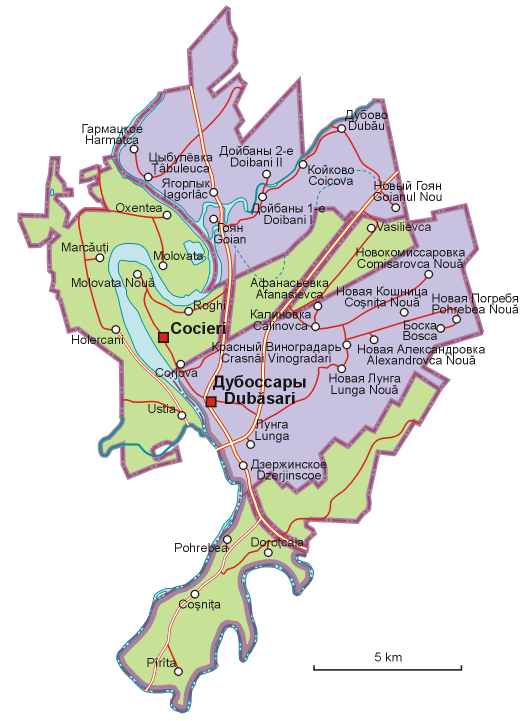|
Doroțcaia
Doroțcaia is a village in the Dubăsari District, Republic of Moldova, situated on the eastern bank of the River Dniester. The village was a place of fighting during 1992 War of Transnistria. It is now under the control of the central authorities from Chișinău. The Grigoriopol Romanian-language school which was not allowed to function by the authorities of Transnistria was moved to the village in 2002. According to the 2014 Moldovan Census, the village had a population of 3,038, of whom 2,976 were ethnic Moldovans, 44 were from ethnic minorities, and 18 were undeclared. Political problems On the eastern edge of Doroțcaia passes the strategic road linking Tiraspol and Rîbnița, and separatist authorities from Tiraspol want to control this road. 85% of Doroțcaia's farmland is across the road. From 2003 Transnistrian authorities tried to prevent farmers from accessing their land. Unable to harvest their crops, the farmers suffered serious losses. This situation lead to an ... [...More Info...] [...Related Items...] OR: [Wikipedia] [Google] [Baidu] |
Dubăsari District
The Dubăsari District () is a district in the east of Moldova, with the administrative center at Cocieri. As of January 1, 2011, its population was 35,200. This does not include the 715 people that live in the village of Roghi, which is controlled by the breakaway Tiraspol authorities. ''Dubăsari'' means ferry-arks (see coat of arms). History The territory which today is part of Dubăsari district has been inhabited since the Stone Age (50–30000 years BC). Location of the earliest documentary attestation of the district is Corjova, first attested in 1362. Other town with old certificate is Holercani village certified in 1464. This region is part of the Grand Duchy of Lithuania during 1386–1434. In 1393-1812 the part of district, situated on the right, of the Nistru is part of the Principality of Moldova. In this period to develop the economy (trade, agriculture), as population increases. In 1790, the part of district, situated on the left of Nistru is occupied by the Rus ... [...More Info...] [...Related Items...] OR: [Wikipedia] [Google] [Baidu] |
Grigoriopol
Grigoriopol (, Moldovan Cyrillic: Григориопол, russian: Григорио́поль, Grigoriopol, uk, Григоріо́поль, Hryhoriopol) is a town in the Administrative-Territorial Units of the Left Bank of the Dniester, Moldova. It is the seat of the Grigoriopol District of Transnistria. The city is located on the left (eastern) bank of the river Dniester at , in central Transnistria. Grigoriopol is composed of the city itself, and a small village ''Crasnoe'' (Красное). The town itself had a population of 11,473 in 2004. In 1996 and in 2002, the town was the centre of a dispute regarding the attempts of local Moldavian inhabitants to use the Romanian language (written with Latin script characters) in the local Moldavian school, which is against the policy of the government of Transnistria. The Transnistrian press attacked the local authorities "that allowed the fifth column of Moldova in Transnistria to operate". The head of the Parent-Teacher Associati ... [...More Info...] [...Related Items...] OR: [Wikipedia] [Google] [Baidu] |
Districts Of Moldova
Countries' first-level (top-level) administrative division Administrative division, administrative unit,Article 3(1). country subdivision, administrative region, subnational entity, constituent state, as well as many similar terms, are generic names for geographical areas into which a particular, ind ...s. ''Please note:'' This category's subcategories contain articles on each subdivision of the country while each directly included article considers the subdivisions structure of the country. ''Further note:'' This category's subcategories are indexed according to country, but its directly included articles are not: they are indexed by type of subdivision (provinces, counties, etc). Articles with non-English subdivision terms in their titles either have their redirects indexed instead, or are indexed by the common English translation for said subdivision. This facilitates comparisons between similarly named subdivisions. {{CatAutoTOC 1st-level ... [...More Info...] [...Related Items...] OR: [Wikipedia] [Google] [Baidu] |
National Bureau Of Statistics Of The Republic Of Moldova
The National Bureau of Statistics of the Republic of Moldova (NBS; ro, Biroul Național de Statistică, abbr. BNS) is the central administrative authority which, as the central statistical body, manages and coordinates the activity in the field of statistics from the country. In its activity, NBS acts according to the Constitution of the Republic of Moldova, the Law on official statistics, other legislative acts, Parliament decisions, decrees of the President of the Republic of Moldova, ordinances, decisions and Government orders, international treaties of which the Republic of Moldova is part of. The NBS elaborates independently or in collaboration with other central administrative bodies and approves the methodologies of statistical and calculation surveys of statistical indicators, in accordance with international standards, especially those of the European Union, and with the advanced practice of other countries, as well as taking into account the peculiarities of the socio-e ... [...More Info...] [...Related Items...] OR: [Wikipedia] [Google] [Baidu] |
Republic Of Moldova
A republic () is a "state in which power rests with the people or their representatives; specifically a state without a monarchy" and also a "government, or system of government, of such a state." Previously, especially in the 17th and 18th centuries, the term was used to imply a state with a democratic or representative constitution (constitutional republic), but more recently it has also been used of autocratic or dictatorial states not ruled by a monarch. It is now chiefly used to denote any non-monarchical state headed by an elected or appointed president. , 159 of the world's 206 sovereign states use the word "republic" as part of their official names. Not all of these are republics in the sense of having elected governments, nor is the word "republic" used in the names of all states with elected governments. The word ''republic'' comes from the Latin term ''res publica'', which literally means "public thing", "public matter", or "public affair" and was used to refer t ... [...More Info...] [...Related Items...] OR: [Wikipedia] [Google] [Baidu] |
Dniester
The Dniester, ; rus, Дне́стр, links=1, Dnéstr, ˈdⁿʲestr; ro, Nistru; grc, Τύρᾱς, Tyrās, ; la, Tyrās, la, Danaster, label=none, ) ( ,) is a transboundary river in Eastern Europe. It runs first through Ukraine and then through Moldova (from which it more or less separates the breakaway territory of Transnistria), finally discharging into the Black Sea on Ukrainian territory again. Names The name ''Dniester'' derives from Sarmatian ''dānu nazdya'' "the close river." (The Dnieper, also of Sarmatian origin, derives from the opposite meaning, "the river on the far side".) Alternatively, according to Vasily Abaev ''Dniester'' would be a blend of Scythian ''dānu'' "river" and Thracian ''Ister'', the previous name of the river, literally Dān-Ister (River Ister). The Ancient Greek name of Dniester, ''Tyras'' (Τύρας), is from Scythian ''tūra'', meaning "rapid." The names of the Don and Danube are also from the same Indo-Iranian word ''*dānu'' "ri ... [...More Info...] [...Related Items...] OR: [Wikipedia] [Google] [Baidu] |
Chișinău
Chișinău ( , , ), also known as Kishinev (russian: Кишинёв, r=Kishinjóv ), is the Capital city, capital and largest city of the Republic of Moldova. The city is Moldova's main industrial and commercial center, and is located in the middle of the country, on the river Bîc River, Bâc, a tributary of the Dniester. According to the results of the 2014 Moldovan census, 2014 census, the city proper had a population of 532,513, while the population of the Municipality of Chișinău (which includes the city itself and other nearby communities) was 700,000. Chișinău is the most economically prosperous locality in Moldova and its largest transportation hub. Nearly a third of Moldova's population lives in the metro area. Etymology The origin of the city's name is unclear. A theory suggests that the name may come from the archaism, archaic Romanian word ''chișla'' (meaning "spring", "source of water") and ''nouă'' ("new"), because it was built around a small spring, at the ... [...More Info...] [...Related Items...] OR: [Wikipedia] [Google] [Baidu] |
Tiraspol
Tiraspol or Tirișpolea ( ro, Tiraspol, Moldovan Cyrillic: Тираспол, ; russian: Тира́споль, ; uk, Тирасполь, Tyraspol') is the capital of Transnistria (''de facto''), a breakaway state of Moldova, where it is the third largest city. The city is located on the eastern bank of the Dniester River. Tiraspol is a regional hub of light industry, such as furniture and electrical goods production. The modern city of Tiraspol was founded by the Russian generalissimo Alexander Suvorov in 1792, although the area had been inhabited for thousands of years by varying ethnic groups. The city celebrates its anniversary every year on 14 October. Etymology The toponym consists of two ancient Greek words: Τύρας, ''Tyras'', the Ancient name for the Dniester River, and ''polis'', i.e., a city (state). History Classical history Tyras (Τύρας), also spelled ''Tiras'', was a colony of the Greek city Miletus, probably founded about 600 BC, situated some ... [...More Info...] [...Related Items...] OR: [Wikipedia] [Google] [Baidu] |
Rîbnița
Rîbnița or Rybnitsa ( ro, Rîbnița or , Moldovan Cyrillic alphabet: Рыбница; russian: Ры́бница, ''Rybnitsa''; uk, Ри́бниця, ''Rybnytsia''; yi, ריבניצע, ''Ribnitse'') is a town in Transnistria (''de facto'') in Moldova (''de jure''). According to the 2004 census, it has a population of 53,648. Rîbnița is situated in the northern half of Transnistria, on the left bank of the Dniester, and is separated from the river by a concrete dam. The town is the seat of the Rîbnița District. History Rîbnița was founded in 1628 as the Ruthenian village Rybnytsia, its name meaning "fishery" (from рꙑба, "fish"). As early as 1657, Rîbnița was mentioned in documents as an important town, at the time part of the Kingdom of Poland. Strong Western European influences can be seen in this formerly Polish town. In 1793, Rîbnița passed from Poland to Russia. On March 17, 1944, during World War II, the Nazis executed almost 400 prisoners, Soviet citizens ... [...More Info...] [...Related Items...] OR: [Wikipedia] [Google] [Baidu] |
Organization For Security And Co-operation In Europe
The Organization for Security and Co-operation in Europe (OSCE) is the world's largest regional security-oriented intergovernmental organization with observer status at the United Nations. Its mandate includes issues such as arms control, promotion of human rights, freedom of the press, and free and fair elections. It employs around 3,460 people, mostly in its field operations but also in its secretariat in Vienna, Austria, and its institutions. It has its origins in the mid-1975 Conference on Security and Co-operation in Europe (CSCE) held in Helsinki, Finland. The OSCE is concerned with early warning, conflict prevention, crisis management, and post-conflict rehabilitation. Most of its 57 participating countries are in Europe, but there are a few members present in Asia and North America. The participating states cover much of the land area of the Northern Hemisphere. It was created during the Cold War era as a forum for discussion between the Western Bloc and Eastern Bl ... [...More Info...] [...Related Items...] OR: [Wikipedia] [Google] [Baidu] |





